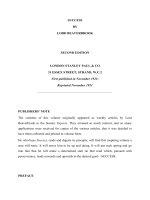WordPress Secrets By Jason Fladlien pot
Bạn đang xem bản rút gọn của tài liệu. Xem và tải ngay bản đầy đủ của tài liệu tại đây (120.17 KB, 5 trang )
WordPress Secrets
By Jason Fladlien
Published by JTD Creatives at Smashwords
Copyright © 2010 Jason Fladlien
License Notes
Thank you for downloading this free ebook. This free ebook may be copied,
distributed, reposted, reprinted and shared, provided it appears in its entirety
without alteration, and the reader is not charged to access it.
~~**~~
Intro
We love WordPress. In a matter of seconds, for free - you can have a pro-looking site that
is very "search engine friendly". And it's so easy to use.
If you haven't messed around with WordPress yet - you're in for a treat. This report will
show you the easiest ways to use WordPress to get traffic, make money, establish a
presence of authority, build a list and do a whole of other cool and profitable stuff.
Installing WordPress
This is really easy. We recommend you use "Fantastico" and you can do it in seconds.
The only requirement is your web hosting has to provide cpanel access. Host Gator is one
of the best and cheapest companies to get a hosting account from to host your blog.
Say your domain was "mydomainURL.com". To log into cpanel, you just type in the
address "mydomainURL.com/cpanel" - it's that easy.
Once you log in, hit control + f and do a find for "fan", and this will reveal a smiley icon
called Fantastico. Click on that, then on the left menu click "WordPress" and follow the
simple step by step instructions. After installation be sure to type in your email address to
have your WordPress settings emailed to you.
You're up and rocking.
Picking Your Theme
There are so many wonderful themes you can choose from to install on your WordPress
blog for free.
Here are some of our favorite resources
»»
»»
»»
Browse through these themes and pick one that you like - then download it to your
computer in a place that's easy to find. Next we're going to install this theme.
To install a theme, just log into your WordPress admin area - You will be given the log-in
URL from Fantastico when you finish installing WordPress. Then put in your admin
name and your user password.
Once logged in, you're in the WordPress admin area. Click On "Appearance" on the left,
and then click on "Add new themes". Next, select "upload" then click "browse". Find the
zip file of the theme you just downloaded and click "Install Now" Next click "activate" to
switch your blog to that theme.
Now if you click "visit site" on the top menu of your WordPress admin panel, you will
see your new theme.
It's really that easy to set up your blog.
Simple Blog Tweaks
The first thing you want to do is make sure your blog gets indexed in the search engines.
That's easy. Click on "settings" in the admin panel, then click on "privacy". Select "I
would like my blog to be visible to everyone".
Next, let's change your "permalinks". These are the things that will help you get traffic
from the search engines. Again, click on "settings, then click on "permalinks". Next, click
on custom structure, and put this in - /%postname/
What this does is slick. When you create a new post, instead of it showing up at a URL
like yourdomain.com/?p=222 it will be yourdmain.com/whatever-your-post-title-is-
named
Again, this will help you get more traffic in the search engines because it makes it more
"Google friendly".
The Difference Between Pages and Posts
Posts are what you'll mainly use when you update your blog. For example at
Jason's latest post shows up directly below the banner ad that he has on
his site.
His pages, on the other hand, show up at the top of the site right next to "Fladlien
Productions". You see pages like home, about, contact us, earning disclaimer, privacy
policy.
So posts will be inserted in your main theme area when you add new content. Pages are
inserted in your navigation bar automatically, wherever that is located at in your theme.
With pages, you can also have hierarchy levels. For example you might have a page you
created that says Resources and you want to put two pages underneath that page. One
might be "reports" and the other might be "software".
When creating a page, first log into your WordPress admin panel. Then click on "pages",
then "add new". Type up your page. Then before you go to publish it, on the right hand
side right below the publish buttons you'll see "attributes".
You'll notice it says, by default "main page(no parent". If you have created previous
pages, you can change your current page to be under another page. That way you have
multiple "levels" so to speak.
And what's cool about the navigation menus in most themes, is they usually have those
cool "drop down menus" so if you hovered over the resources link, it'd show a drop down
menu of both reports, and software. Cool stuff!
Auto-scheduling Posts
First, let's create a post real quick. To do this just click on "posts". While we're there, let's
delete the default "hello world" post. Just click "delete", and it's gone. Now click "add
new" on the left hand menu below "posts".
Write up your post. Then on the right hand side you can click publish and it should show
up when you go to your site.
Let's say you have 10 or 12 posts and you don't want to publish them at once. That's cool.
You can schedule when a post gets published real easy. Just above the "publish" button is
something that says "Publish immediately edit", with the edit showing up as a link you
can click.
Click that "edit" link, and then pick the time and date you want to publish that post.
Sweet!
Widgets
Back at jmflad.com you see on the right-hand menu a section called "products". And then
a whole list of products. That's actually a widget called "links".
These things are so easy to put on your blog. In your WordPress admin panel, just click
on "appearance", then click on "widgets".
See the widget that says "links"? Just drag and drop it into your sidebar on the right side
of the window. Name the widget and press "save". Ta-da, you're done.
Now, the problem with using the links widget is that it starts out with the default links
that come with WordPress when you first install it. That's no good. Let's fix that. In your
admin panel, click on the tab that says "links" on the left hand side.
Then delete all those default links, and add in your own.
There are other real quick widgets you might want to consider adding - like the "pages"
widget, the "recent comments" widget, the "search" widget and one of our favorites: the
"text" widget.
The text widget you can use for anything. ANY html you would use on a normal site
would work here. So if you have an email capture form generated by an autoresponder
provider like AWeber, you can just copy that code and past it in your text widget.
Again, to activate any widget, just drag and drop it into the sidebar.
Plugins
Plugins are one of the coolest things about WordPress. In the admin area, click on the tab
called "plugins" on the left.
A great plugin to install is called "Google Sitemap". So let's install it. Click on "add new"
under the plugin menu.
Then in the search field, type in "google sitemap". There you will see various plugins.
Find the one that says "google xml sitemaps". Then way over on the right - click on
"install". A window will pop up giving your more information about this plugin. Click
"Install Now" After it installs, it will take you to a screen where you can click "activate
plugin". Do that now.
Next, let's configure the plugin. To do that click on the "settings" tab on the left side of
your admin panel. That's where the settings of almost all your plugins will be at. This one
says "XML Sitemap".
First you will have to build your sitemap - just click on the "click here" link. A sitemap is
great to use by the way because it helps index ALL the pages and posts on your blog so
you get more exposure to the search engines.
There are settings there you can tinker with if you wish, but really that's all you have to
do and your site map is taken care of for you.
Nice.
Here is a list of some other handy dandy plugins you can use:
WordPress Backup - Plugin that backs up your current WordPress
theme, WordPress plugins, images, and other non-database stuff.
All-in-One SEO Pack - The Ultimate SEO WordPress plugin.
WP-ContactForm - A way for people to contact you without actually
emailing you, saves time, and is a great way to avoid spam.
WordPress.com Stats - You can have simple, concise stats with no
additional load on your server by plugging into WordPress.com's stat
system
Broken Link Checker - A plugin for WordPress that checks your posts for
broken links, and lets you know if any are found.
TweetMeme Button - Adds the TweetMeme button into your posts and
RSS feed.
Conclusion
There is a lot of opportunity with WordPress. If you get good at it, you can actually make
a small fortune designing websites for others and using it to create your own money
getting sites.
And we've just scratched the surface of WordPress' potential with this simple little report!
###
Connect with Me Online:
Blog:
Website: />Smashwords: />









